VISIT PRUDHOE CASTLE WITH ENGLISH HERITAGE MEMBERSHIP
- Up to 6 Kids go free
- Free Parking at English Heritage
- Receive our Handbook
- Unlimited access to over 400 days out

TICKETS & PRICES
Adults: £7.60
Children 5-17 Years: £4.60
Families (2 adults, up to 3 Children): £19.80
Families (1 adult, up to 3 Children): £12.20
Quick Navigation
Visiting Castle
Dating back to the 11th century Norman Conquest of England, Prudhoe Castle is a ruined castle located in Northumberland. Today, the property is also home to a Georgian mansion dating back to the early 19th century and is a popular tourist site.
The ruined castle and the grounds that make up the castle complex are all open to visitors and tourists. English Heritage manages the site, and tickets are generally required. Check current guidelines before scheduling a visit. It takes just under an hour to tour the property, though you can also enjoy a picnic on the grounds.
Parking
There is free parking space located about 70 meters (230 feet) from the entrance to the castle. The area also has room for two disabled visitor cars.
Price
- Adults: Starts at £6.90
- Children (5-17 years): Starts at £4.10
- Family tickets (2 adults, max 3 children): Starts at £17.90
- Family tickets (1 adult, max 3 children): Starts at £11.00
- Concessions: Starts at £6.20
- Overseas Visitors Pass (unlimited visits for either 9 or 16 days): Prices start at £37.00 and cover access to over 100 historic sites and monuments
Opening
In general, the castle is open from 10:00 am to 5:00 pm. However, it’s not open every day, and the dates on which you can visit the site vary depending on various factors. For updated information, please check current guidelines before planning a trip.
Location and Access
Castle View, Ovingham, Prudhoe NE42 6NA
The castle is located in southwest Prudhoe, off Station Road. There are clear signs directing you to the property.
Know Before You Go
- Light refreshments, including snacks, drinks, and ice cream, are available for purchase.
- Picnics are allowed on the grounds. There are some picnic benches available, as well as grassed areas outside the manor house and in Pele Yard you can use.
- There’s a gift shop on-site selling souvenirs.
- No ball games are allowed within the castle walls, though they can be played in Pele Yard. No kites are permitted.
- While commercial photography is allowed, some areas are restricted. It’s recommended that you contact English Heritage if you plan to visit for photography and filmography purposes.
- There’s a family room on-site, complete with games, books, and more.
- You can find an exhibition detailing the castle’s history and showcasing some of the artifacts found at the site on the ground floor of the house on the property.
- The ground floor area of the house is wheelchair accessible, and accessible toilets are available. The grounds can also be accessed by wheelchair users.
- Assistance dogs are permitted in the castle.
- You can only access the upper floor of the manor house and the chapel via a flight of steep steps.
Places To Stay Nearby
Valley View
The Valley View starts at £55 per night; it offers lake and garden views and is located near yet another castle, Stockfield’s 15th century Bywell Castle. (Bywell, alas, is still privately owned and isn’t open to visitors). Reviewers praise Valley View’s friendly service.
Ovington House
Ovington House offers wi-fi, a continental breakfast, and some breath-taking views of the rolling Northumberland countryside. At £92 per night, the setting is tranquil, the hosts are gracious, and you’ll enjoy a pleasant stay amongst some of England’s greenest and most pleasant land.
Premier Inn Newcastle City Centre (Quayside)
When you’re done exploring Prudhoe Castle, Premier Inn’s The Quayside hotel will be a great place to check out Newcastle’s nightlife and restaurant opportunities, not to mention scenic walks along the Tyne. Price starts at £86 per night.
History of Castle
The first castle on the site where Prudhoe Castle stands today dates back to the 11th century and was a motte and bailey castle. After the Norman Conquest, Prudhoe became the seat of the Umfraville family. The castle passed to the Percy family in the late 14th century and was given over to the Crown in 1966.
Time Line
-11th Century
The first motte and bailey castle was built at the site. The property was given over to the Umfraville family by Henry I, following the Norman Conquest. However, there were some indications that the castle was already in their possession at this time.
-1173
The head of the family, Odinel II, refused to support William the Lion of Scotland’s claim to the earldom of Northumberland. The Scottish army attempted to take the castle, but the attempt failed.
-1174
William tries to retake the castle but leaves after a failed siege of three days.
Stone Keep and Great Hall
The keep is located at the center of the inner bailey and is still standing today. However, only the ground floor is accessible, and the roof is no longer visible. As the original Norman entrance was located on the first floor, the doorway can still be seen. This doorway was repurposed into a window in the 1330s.
The original great hall is no longer visible, though it’s hidden beneath the ground.
-1178
Odinel II died, and the castle passed to his son, Richard.
-Late 12th Century-Early 13th Century
Richard stood against King John, leading to his properties and estates being forfeited to the Crown. His estates were returned in 1217, following King John’s death in 1216.
-1228
Richard died, and the castle passed to his son Gilbert.
-1245
Gilbert died, and the castle passed to his son Gilbert II. Gilbert II also inherited the title of Earl of Angus from his mother, as well as vast Scottish estates.
-Mid-Late 13th Century
Gilbert II took part in the conflicts between Henry III and his barons and was also a participant in the Scottish expeditions of Edward I.
-1308
Gilbert II died and was succeeded by his son Robert De Umfraville IV.
-1314
Robert was taken prisoner by the Scots. Though he was soon released, he was deprived of his Scottish estates and the earldom of Angus.
-1316
King Edward granted Robert 700 marks as an allowance so he can maintain a garrison at Prudhoe Castle. The garrison was made up of 40 men-at-arms and 80 light horsemen.
-1381
The last of the Umfrevilles, Gilbert III, died without children.
-Late 14th Century
Gilbert III’s widow married Henry Percy, 1st Earl of Northumberland. She died in 1398, and Prudhoe Castle passed into the possession of the Percy family.
-1405
Prudhoe Castle was forfeit to the Crown due to Henry Percy’s participation in the Battle of Shrewsbury against King Henry IV. It’s granted to John of Lancaster, one of the king’s sons and the future Duke of Bedford, and remained in his hands until his death in 1435 when it returned to the Crown.
-1440
The Percies regained ownership of Prudhoe following a legal battle.
-1462
Prudhoe was granted to George, Duke of Clarence, by his elder brother Edward IV. This was due to Henry Percy, 3rd Earl of Northumberland’s death during the War of the Roses, during which he fought on the side of Lancasters.
Shortly after granting the castle to the Duke of Clarence, Edward IV transfers it to Lord Montague.
-1470
The castle was restored to Henry Percy, 4th Earl of Northumberland.
The New Great Hall
A new great hall was built during the 15th century. However, after the castle became less important to the Percies, it was torn down in the 16th century and replaced with a smaller hall.
-Mid-16th Century
The castle was home to Henry Percy, 6th Earl of Northumberland, and his brother, Sir Thomas Percy. Both men were part of the Pilgrimage of Grace in 1536 and were executed following a conviction for treason.
Following their executions, the castle was forfeit.
In August 1537, Prudhoe was reported to have several habitable homes and towers within the castle walls, though they were said to be in disrepair.
-Late-16th Century
The castle was restored to Thomas Percy, the 7th Earl of Northumberland, in 1557. However, he was convicted for his part in the Rising of the North in 1569 and was executed in 1572.
-17th and 18th Centuries
Prudhoe was no longer used as a residence by the Percies during the 17th century. It was instead let out to tenants.
By 1776, the castle was reported to be ruined.
-19th Century
Hugh Percy, 2nd Duke of Northumberland, repaired the castle and surrounding property between 1808 and 1817. He also replaced the many homes within the walls of the castle with a Georgian mansion.
-The Mansion
The Georgian mansion incorporated the original medieval walls of the castle and combined them with Regency-style architecture and Egyptian motifs to create a unique house. The number of public reception rooms in the home is a reference to the fact that the home was meant to be occupied by a gentleman who played an active part in society.
-20th Century
Prudhoe was handed over to the Crown in 1966. English Heritage takes over custody and opens it to visitors.
Castle Occupants
12th Century Occupants
- Late 11th Century-1182: Odinel II
- 1182-1226: Richard, with a gap of a few years when the castle was forfeit
13th Century Occupants
- 1226-1245: Gilbert
- 1245-1308: Gilbert II
14th Century Occupants
- 1308-Mid-14th Century: Robert De Umfraville IV
- Late 14th Century-1381: Gilbert III
- Late 14th Century-1405: Henry Percy, 1st Earl of Northumberland
15th Century Occupants
- 1405-1435: John of Lancaster
- 1440-1461: Henry Percy, 3rd Earl of Northumberland
- 1462: George, Duke of Clarence
- Mid-Late 15th Century: Lord Montague
- 1470: Henry Percy, 4th Earl of Northumberland
16th Century Occupants
- Mid-16th Century-1536: Henry Percy, 6th Earl of Northumberland, and his brother, Sir Thomas Percy
- 1557-1572: Thomas Percy, 7th Earl of Northumberland
19th Century Occupants
- 1808-1817: Hugh Percy, 2nd Duke of Northumberland
Images of Castle
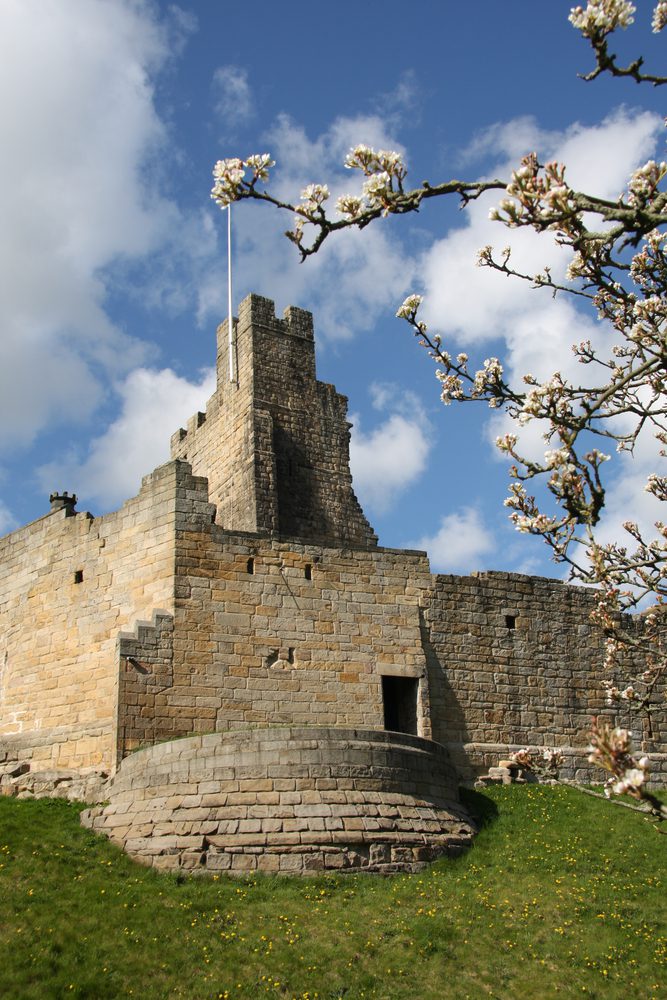
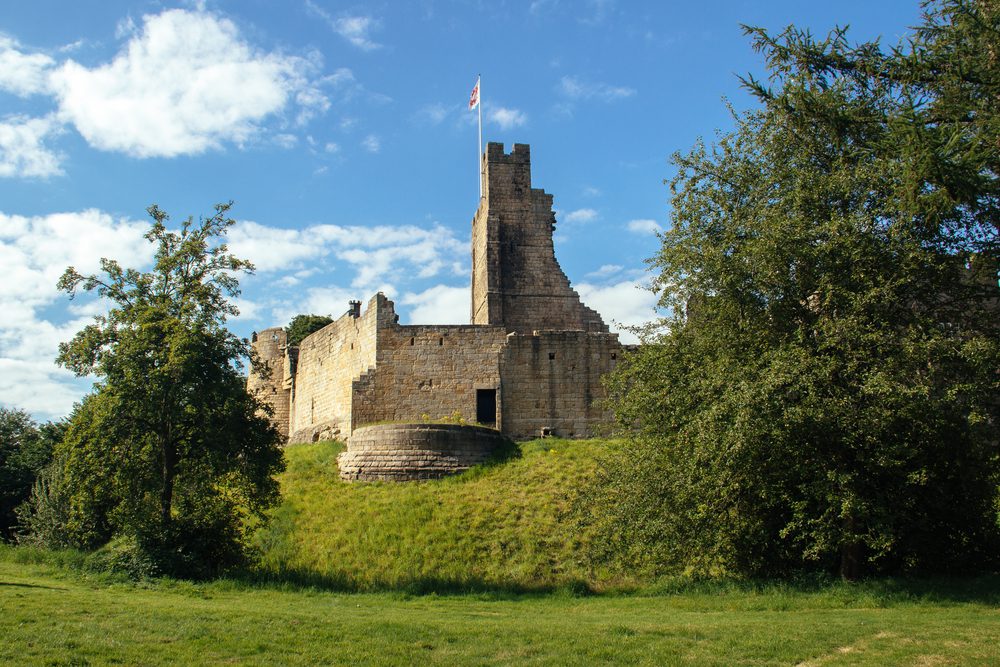
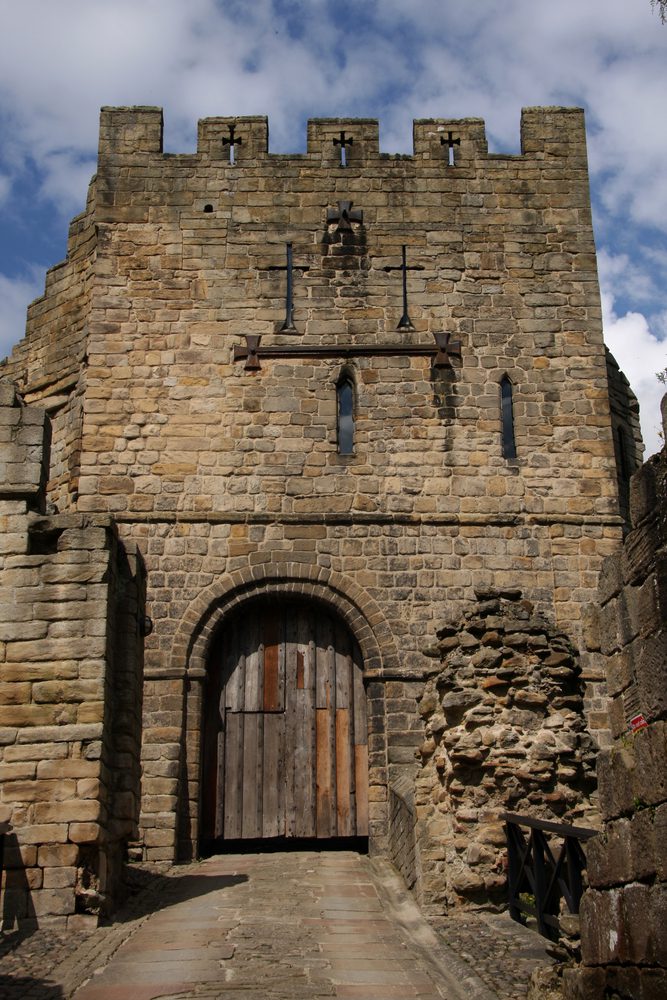
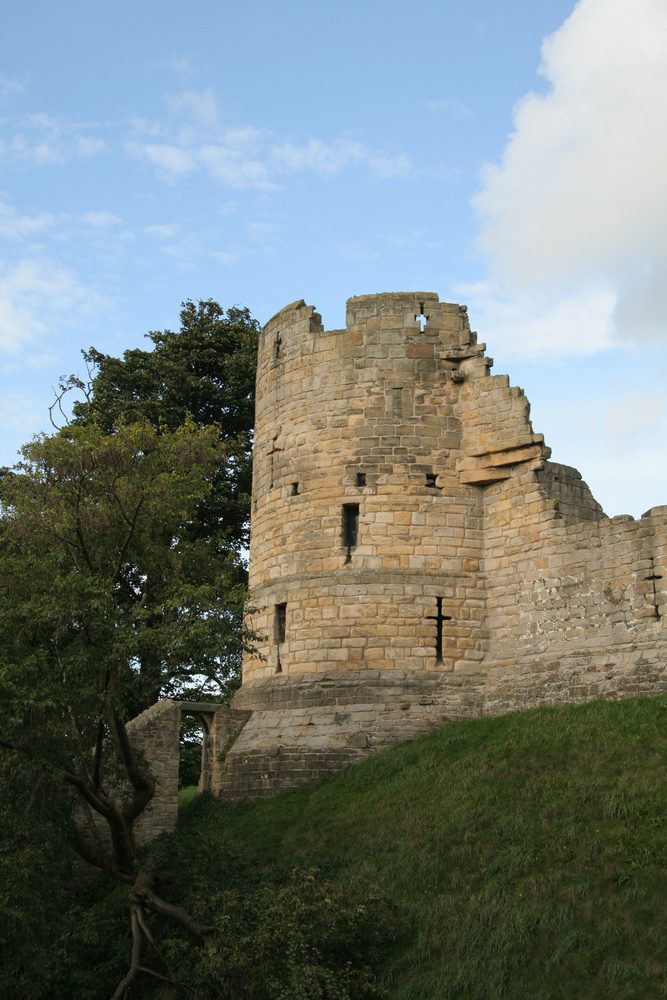
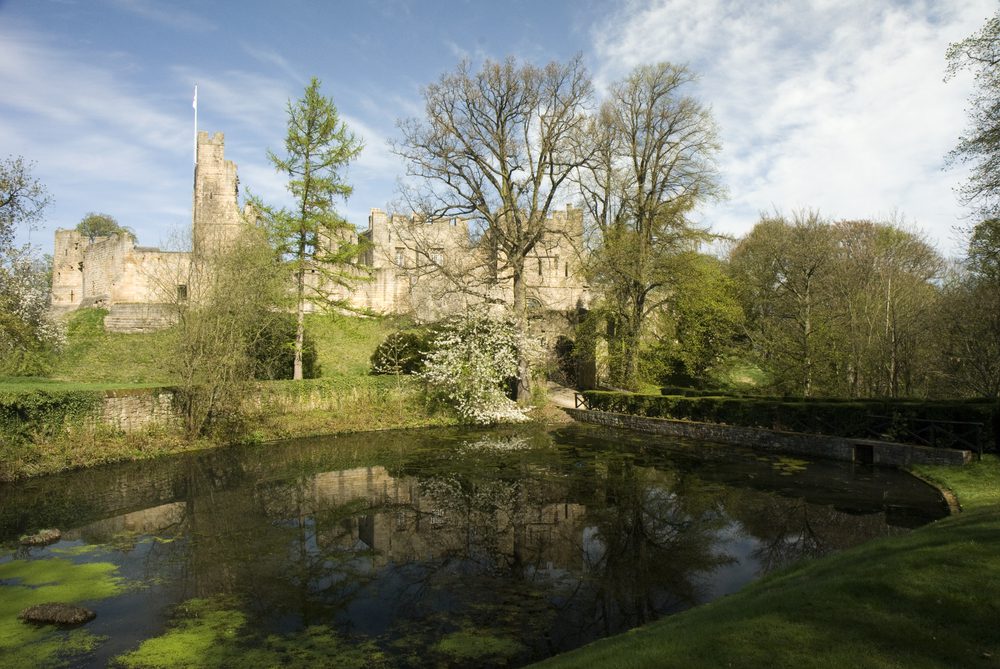

Images Supplied and licensed from Shutterstock Standard Licence Package
Castle Facts
The castle is a Grade I Listed Building and a Scheduled Ancient Monument. The Georgian mansion was designed by David Stephenson, the first architect from Newcastle to be trained in London.
Prudhoe was the only castle in Northumberland to resist the Scots.
You can only access the castle via its original, fortified gatehouse, which was built before 1150
The chapel’s oriel window is considered one of the earliest examples of such a window in an English castle.
Castle Q&A
What Parts of the Original 12th Century Castle Are Still Viewable?
While Prudhoe has undergone significant renovations over the last 900 years, you can still see the original 12th century keep at the center of the inner bailey. Additionally, the fortified gatehouse that is the castle’s entrance was also built in the 12th century and dates to sometime before 1150.
Which Section of the Castle Is the Best Preserved?
While the castle walls are in fantastic shape given their age, the 19th-century Georgian mansion is undoubtedly the best-preserved section of Prudhoe.
What Type of Castle Is Prudhoe?
The original castle at the site was a motte and bailey castle. However, the current castle is a result of several improvements and additions in the subsequent centuries and can best be termed a medieval castle.
Location of Castle
The castle has remained in the same place since its construction in the 12th century. It is currently located on the south bank of the River Tyne in Prudhoe and is off the A695. The property can be accessed via car, as well as via bus, train, and bicycle.
Other Places To Visit Near Castle
Hadrian’s Wall, Heddon-on-the-Wall
This is a stretch of Hadrian’s Wall and offers visitors the chance to view the Corbridge Hoard, iron artifacts excavated in 1964. Over 1,000 years before Prudhoe Castle was built this region marked the borderland between Roman Britannia and Pictish Caledonia.
Derwentcote Steel Furnace
This is one of the earliest and most complete steel-making furnaces still standing in Britain. Built in the 1720s, Derwentcote steel was used in the high-quality springs and cutting tools of the early Industrial Revolution. Free guided tours are available with pre-registration.
Aydon Castle
Also known as Aydon House, this manor house was originally home to the de Raymes family and played a significant role during the Scottish Wars of Independence. Aydon House is one of England’s finest surviving examples of a 13th century manor house.
St. Andrew’s Church
Construction of this Bywell church started in the 9th century, and the tower was initially used as a defensive structure. Additions were made over the years, and construction was only complete in the 18th century. Today, it’s a Grade I listed building.
